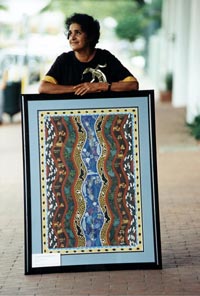|
Expressing and
communicating significance in other
ways
|

|
The significance of
a place can also be expressed in creative
ways, such as using video, songs, displays
or artworks, as well as a written
statement. This can be a very powerful way
of communicating to others how important a
place is.
Here Shirley
Swindley holds her painting which depicts
the significant values of a woman's
fertility place sacred to Ku Ku Yalangi
elders.
|
.
Two views of
Gulaga
The following two
'statements' are about the same place - Gulaga, or
Mt Dromedary, on the NSW south coast. The first -
Gulaga, the Mother - was submitted by Seph
Scorzazie as a written entry in the Australian
Heritage Commission's creative writing competition
- Heritage Rave. It won a Special Merit
award. The words convey a very personal view of why
Gulaga is worth protecting.
The second 'statement' is
part of the narration of the winning professional
video in the Commission's video competition -
Heritage in Focus. It was submitted by David
Arvind Condon and Hiromi Matsuoka. The words are
spoken by two Yuin elders.
1. Gulaga, The
Mother
The Great Woman Gulaga lies
beside me with her children muddling in the folds
of her skirt and I see her young son who is called
back after he left home for the sea. That's
Montague Island just off the coast. The myth tells
how he is joined to his mother through an umbilicus
that runs under the ocean to her innerness.
Dolphins are said to swim that tunnel that connects
that great woman to her son. The legend is that she
is the site where the world began.
One of the local Aboriginal
women at Wallaga Lake on the far south coast of New
South Wales says, "Gulaga is a sacred mountain
because the Creative Beings were there in the past
and because they are there still. To engage with
the mountain is to engage with spirit". Her clarity
on sacredness is this: "Sacred events are events
authorised by the Creative Beings and engaged in by
human beings as a way of sustaining spirit in human
life…".
My deep wish is for Gulaga to
remain undamaged by human habitation. That amongst
all these changes going on in all our lives she
remains unchanging and stable. And yet forever
changing that fabulous auric garb. Oh those divine
gossamer pearl shell numbers - so
elegant.
In my early morning run
around the waking village I come over the crest of
the hill and there she is, directly ahead of me,
and I'm running with my daughter towards her. I
feel an invisible bolt of energy in my solar plexus
as her hugeness enters and fills all of my visual
perception. I am breathing hard, my daughter has
gone ahead of me. It's 6.30am, the day has begun
and I've been blessed by her presence
again.
2. Gulaga
(excerpt from video narration
by David Arvind Condon and Hiromi
Matsuoka)
Max Harrison, Yuin
Elder
'At the beginning, before
Dharama the Great Spirit created Tunku and Naadi
there was only oneness.
Ann Thomas, Yuin
Elder
'Our Creation Story on the
south coast of Tunku and Naadi coming down from the
stars - they came from the stars to this beautiful
land. They became this earth, they became part of
the stones, the rocks, the clay. They became part
of the trees and the mountains themselves...and the
oceans. And they developed from the earth…and
all our energies and everything else that we are is
in those rocks at Gulaga and every other teaching
place. And so we became part of the earth. We never
profess to own the land, but the land owns
us.
Max:
'Dharama the Great Spirit, He
created everything. Dharama is Creation
itself.
Ann
'Tunku and Naadi came to this
land. There was no-one living here, but there was
the environment; there were the fish and the
whales, the birds, the animals - they gave them all
names.
Max
'The culture is in the trees,
in the bush, in the waters, in the animals, the
birds. All this oneness, all this Creation around
us.
'Mother Earth, Father Sky,
Grandmother Moon and Grandfather Sun. That is so
important. Dharama's Creation is all our
relations.
Ann
'Tunku and Naadi were looking
at the land, looking at the environment, looking at
the fish, looking at everything and renaming them.
The Aboriginal people believe that they are
co-creators, so this is the creation of most things
that were happening and developing.
Max
'What we have to do is go
back to the One Time, of how it was…and bring
that culture back the way it was. It's the Lore
we're bringing back here: respect. Respect of the
Mother Earth: respect to the trees, to the rocks,
to the waters - to all sacred and significant sites
that we have. That's the power of this place, to
really bring you back.
 ..... .....
|